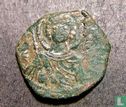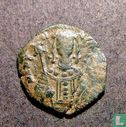

Enlarge image


Catalogue information
LastDodo number
5714683
Area
Coins
Title
Byzantine Empire tetarteron Emperor Manuel I Comnenus 1143-1180 AD
Country
Face value
Year
1143
Variety / overstrike
Type
Designer
Series
Theme
Material
Weight
2
Diameter
19
Thickness
Punch
Shape
Obverse
P-over-w GIOC (bust facing of St. George)
Reverse
MANVHL DECP(OTH )
Edge
Privy mark
Mint mark
Number produced
Krause and Mishler number
Catalogue number
SB 1975
Details
Thessalonica mint
Manuel reigned over the Byzantine Empire during a crucial part of its history. The empire, founded by Constantine, had seen many changes in the eight centuries leading up to Manuel’s reign. Soldiers of Islam had swept into Egypt, Palestine, Syria, the western provinces of the Roman Empire, North Africa, and Spain. The Normans of Sicily had taken control of Italy and the Seljuk Turks had done the same in Anatolia. All that remained Byzantine was Asia Minor in the east and the Balkans in the west.
Manuel’s goal during his 37 yearlong reign was to restore the Roman Empire. He enjoyed many military successes and treaties especially in Mediterranean countries; however, his neglect of the eastern frontier in Asia Minor, led to a crushing defeat against the Turks in 1176 A.D. Though he was remembered as a brilliant leader, he also spent huge amounts of money for mercenaries to keep the peace on the empire’s frontiers and on a magnificent court in Constantinople. These factors actually led to a rapid collapse of the Byzantine Empire in subsequent years as western Crusaders, Turks, and Muslims encroached.
St George of Lydia was a highly successful Imperial Guard in Diocletian’s court around 300 A.D. His Christian father had also been a Roman officer whom Diocletian had known. When Diocletian issued his anti-Christian edicts, which included arresting all Christian soldiers, George was faced with a dilemma. Renounce his faith and offer sacrifice to the Roman gods, or face death. George refused the emperor’s orders and was executed by decapitation outside Nicomedia’s city walls. Legends arose about George, including a story that he had slayed a dragon, and he later became one of the most venerated saints among most of the early Christian orthodoxies (including Roman, Eastern, Anglican, and Orthodox).
The Byzantine tetarteron replaced the follis after the “cupped” trachy had been overused and follis was debased and made much smaller.



